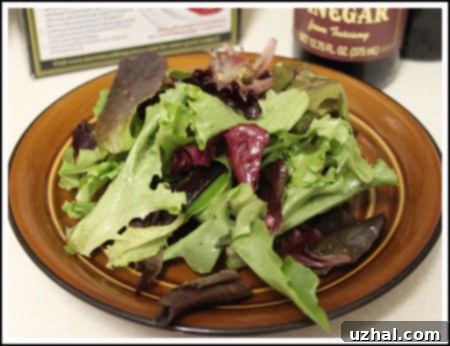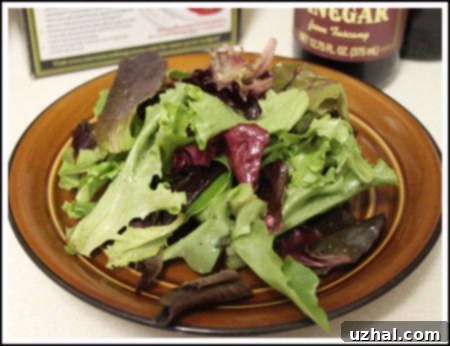The Ultimate Homemade Blender Vinaigrette: Janet’s Easy & Flavorful Recipe
Discover the secret to a truly exceptional salad with Janet’s Blender Vinaigrette. This isn’t just any salad dressing; it’s a vibrant, homemade concoction shared by my friend Janet, meticulously designed to elevate your greens. Its delicate yet rich flavor profile makes it perfectly suited for Spring Mix and other soft, tender lettuce varieties. Unlike heavy, store-bought dressings that can weigh down delicate leaves, this vinaigrette clings lightly, enhancing every bite with a burst of freshness without overpowering the natural taste of your salad. A little goes a long way, ensuring your salads are always perfectly dressed, never drowned.
Why Homemade Vinaigrette is a Game-Changer
Since first embracing this recipe, I’ve experimented with countless variations of vinegars, oils, and fresh herbs, yet always returning to its brilliant core formula. The beauty of this dressing lies in its incredible simplicity and adaptability. You can effortlessly prepare it in a standard blender or a food processor, making it accessible to any home cook. For smaller, more frequent batches, I particularly love using the compact chopper cup that came with my immersion blender. It’s ideal for making just enough to last a few days, ensuring peak freshness and flavor every time.
Beyond its ease of preparation, crafting your own vinaigrette offers numerous advantages. You gain complete control over the ingredients, allowing you to avoid the artificial preservatives, excessive sugars, and unhealthy fats often found in commercial dressings. This homemade version is naturally gluten-free and can be easily adapted to be vegan by choosing plant-based oils. It’s also incredibly cost-effective, turning simple pantry staples into a gourmet dressing that elevates even the most basic salad.
The Story Behind the Recipe’s Ownership
While the base of this fantastic recipe originates from Southern Living, its true essence comes from personal adaptation and love. Janet, my dear friend, made it her own through subtle tweaks and consistent perfection, just as I’ve done since. There’s a certain joy in taking ownership of a recipe, giving it your personal stamp. I encourage you to do the same – make it yours, name it something that resonates with you, and truly integrate it into your culinary repertoire.
I must apologize that the accompanying photo showcases a beautiful salad rather than the dressing itself. However, I needed a visual, and my last batch, made with red onion and robust red wine vinegar, resulted in a charmingly pink hue. While it tasted absolutely magnificent, I decided a classic green salad would be a more universally appealing visual for this introduction. It serves as a perfect reminder that this vinaigrette is incredibly versatile and will look and taste wonderful no matter your ingredient variations.
Update: Although time passes and life moves on, and I haven’t heard from Janet in a while, her legacy lives on in my kitchen. I continue to make her blender vinaigrette often, a testament to its enduring deliciousness and simplicity. It remains a staple, a beloved recipe that never fails to impress and delight.
Tips for Mastering Your Blender Vinaigrette
Creating a perfect vinaigrette is all about achieving a stable emulsion – where oil and vinegar, which naturally repel each other, are coaxed into a harmonious blend. The key to this process is slow and steady addition of the oil while the other ingredients are vigorously blended. This allows the blender to break the oil into tiny droplets, dispersing them evenly throughout the vinegar and other components, creating a creamy, cohesive dressing that won’t separate quickly.
Choosing Your Ingredients Wisely
- Vinegar: The recipe calls for cider or white wine vinegar, offering a bright, crisp base. However, don’t shy away from experimenting! Red wine vinegar will lend a bolder, fruitier note (and a lovely pink hue, as I discovered!). Balsamic vinegar can add a touch of sweetness and depth, while rice vinegar brings a milder, slightly sweeter Asian-inspired flavor.
- Onion & Garlic: These aromatics are the soul of the vinaigrette, providing layers of pungent, savory flavor. Freshly chopped onion and garlic are indispensable. For a milder flavor, you can briefly sauté the onion before adding, or for an extra kick, consider adding a pinch of garlic powder in addition to fresh cloves. I wholeheartedly endorse using the maximum amount of garlic suggested – it truly enhances the dressing’s character.
- Sugar: Sugar plays a crucial role in balancing the acidity of the vinegar, creating a well-rounded flavor profile. Granulated sugar works perfectly, but you could also experiment with a touch of honey or maple syrup for different nuances of sweetness. Adjust to your personal preference; some prefer a tangier dressing, while others like it slightly sweeter.
- Salt & Dry Mustard: Salt is a fundamental flavor enhancer. Dry mustard (like Colman’s) is not just for flavor; it acts as a powerful emulsifier, helping to bind the oil and vinegar together, preventing separation. Don’t skip it!
- Pepper: Freshly ground black pepper is always superior to pre-ground for its robust aroma and flavor. White pepper can also be used for a less visible speckle in lighter dressings.
- Oil: The recipe suggests vegetable oil or olive oil. Vegetable oil provides a neutral base, allowing the other flavors to shine. Olive oil, especially extra virgin, will impart its own distinct fruity and peppery notes. For a lighter taste, use a mild extra virgin olive oil or a blend. The amount of oil can be adjusted – less oil will result in a more acidic, punchier dressing, which I often prefer, especially for delicate greens. More oil will yield a richer, milder, and thicker vinaigrette.
Enhancing Emulsification and Flavor
The magic happens in the blender. After combining all ingredients except the oil, give them a good whir. This thoroughly chops the onion and garlic, releasing their flavors and creating a smoother texture. Then, while the blender is still running, slowly, slowly, slowly drizzle in the oil. This gradual addition is key to forming a stable emulsion. A steady, thin stream allows the blades to incorporate the oil droplet by tiny droplet, resulting in a creamy, cohesive dressing.
If you’re making a small batch in an immersion blender’s chopper cup, you might find the small opening on the lid perfect for this slow-drizzle technique. For larger blenders, some models have a small cap in the lid that can be removed for drizzling. Take your time with this step – patience will be rewarded with a beautifully emulsified vinaigrette.
Creative Customizations and Serving Ideas
One of the greatest joys of this blender vinaigrette is its adaptability. Once you master the basic formula, the possibilities for customization are endless:
- Herbal Infusions: Incorporate fresh herbs like dill, parsley, chives, oregano, thyme, or rosemary directly into the blender with the other ingredients. Dried herbs can also work, but use a lesser amount as their flavor is more concentrated.
- Spice It Up: Add a pinch of cayenne pepper or red pepper flakes for a subtle heat. Smoked paprika can add depth, while a tiny hint of cumin can bring an unexpected, warm note.
- Citrus Zest: For an extra layer of brightness, grate in a bit of lemon or orange zest, or add a splash of fresh lemon or lime juice to the vinegar mixture.
- Different Mustards: While dry mustard is excellent, a teaspoon of Dijon mustard or whole-grain mustard can add a lovely tang and help further stabilize the emulsion.
- Nutty Flavors: For a gourmet twist, consider using a portion of a specialty oil, such as walnut oil or avocado oil, though these are best added at the very end or used in combination with a neutral oil, as they can have strong flavors and lower smoke points.
This versatile dressing isn’t just for delicate spring mixes. It shines equally well on heartier greens like kale or romaine. Try it in pasta salads, drizzled over grilled vegetables, or even as a marinade for chicken, fish, or tofu. Its bright, zesty character can transform simple ingredients into a memorable meal.
Storage and Shelf Life
Once prepared, store your homemade blender vinaigrette in an airtight container in the refrigerator. It will typically last for about 1-2 weeks. It’s normal for some separation to occur over time, especially if you used an oil that solidifies slightly when cold (like some olive oils). Simply give it a good shake or a quick whisk before each use to re-emulsify. The flavors will deepen over time, making it even more delicious on the second or third day!
Now, let’s get to the recipe that started it all!
- Janet’s Scotcheroos
- Six Inch Red Velvet Cake
- Good Pie Crust Recipe
- Cook’s Country Red Velvet Cake
- Pillsbury Gluten-Free Flour Chocolate Chip Cookies
Recipe

Janet’s Blender Vinaigrette
By Anna
Pin Recipe
Ingredients
- ½ cup cider vinegar or white wine vinegar for a classic, bright flavor
- 3 Tbs chopped onion freshly chopped for best flavor
- 2 ½ Tbs sugar to balance acidity; adjust to taste
- 1-3 large cloves garlic I always use the max for bold flavor!
- 1 teaspoon each salt and dry mustard essential for flavor and emulsification
- ½ teaspoon pepper freshly ground black pepper preferred
- ½ to 1 cup vegetable oil or a high-quality olive oil; adjust amount for desired sweetness/acidity
Instructions
-
Combine all ingredients except the oil in your blender or miniature food processor. Blend thoroughly until the onion and garlic are finely chopped and the mixture is well combined. This ensures all flavors are fully incorporated.
-
With the blender still running on a medium speed, slowly and steadily pour in the vegetable or olive oil through the lid’s opening. This slow drizzle is crucial for creating a stable emulsion, resulting in a creamy, cohesive vinaigrette. Continue blending for another 30 seconds after all the oil has been added, or until the dressing is perfectly smooth and emulsified.
